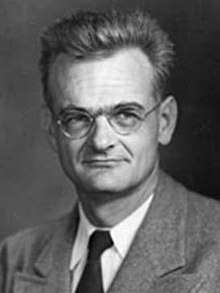Clarence Zener
Clarence Melvin Zener (December 1, 1905 – July 2, 1993) was the American physicist who first (1934[1]) described the property concerning the breakdown of electrical insulators. These findings were later exploited by Bell Labs in the development of the Zener diode, which was duly named after him.[2] Zener was a theoretical physicist with a background in mathematics who conducted research in a wide range of subjects including: superconductivity, metallurgy, ferromagnetism, elasticity, fracture mechanics, diffusion, and geometric programming.
Clarence Zener | |
|---|---|
 | |
| Born | Clarence Melvin Zener December 1, 1905 Indianapolis, Indiana, U.S. |
| Died | July 2, 1993 (aged 87) Pittsburgh, Pennsylvania, U.S. |
| Nationality | American |
| Education | |
| Employer |
|
| Known for | Zener diode Zener effect Zener ratio Zener–Hollomon parameter Landau–Zener formula Thermoelastic damping Zener Prize |
Zener was born in Indianapolis, Indiana and earned his PhD in physics under Edwin Kemble at Harvard in 1929. His thesis was entitled Quantum Mechanics of the Formation of Certain Types of Diatomic Molecules. In 1957 he received the Bingham Medal for his work in rheology, in 1959 the John Price Wetherill Medal from The Franklin Institute, in 1965 the Albert Souveur Achievement Award, in 1974 the Gold Medal [3] from American Society for Metals, in 1982 the Von Hippel Award [4] from the Materials Research Society, and in 1985 received the ICIFUAS Prize for the discovery of the Zener effect, pioneering studies of anelasticity in metals[5] and prediction and observation of thermoelastic damping. A notable doctoral student of Zener's was John B. Goodenough and Arthur S. Nowick held a postdoctoral appointment under Zener.
Zener was known both for his dislike of experimental work and for preferring to work on practical problems within the arena of applied physics, in which he was very insightful. Although he had a reputation of being very successful in these endeavors, he apparently considered himself as being less qualified to work on purely theoretical physics problems. In recognition of this, he once commented that after dining with physicist J. Robert Oppenheimer: "when it came to fundamental physics, it was clear there was no point in competing with a person like that."[6]
Career
Zener held the following posts/appointments:[7] He was a research fellow at the University of Bristol from 1932 to 1934. He taught at Washington University in St. Louis (1935–1937), the City College of New York (1937–1940), and Washington State University (1940–1942) before working at the Watertown Arsenal during World War II. After the war, he taught at University of Chicago (1945–1951) where he was Professor of Physics,[1] before being appointed as Director of Science at Pittsburgh's Westinghouse (1951–1965).[8] Here he developed his system of Geometric programming, which he used to solve engineering problems using adjustable parameters, defined by mathematical functions. Using this, Zener modelled designs for heat exchangers, to perform ocean thermal energy conversion, and discovered the most suitable areas for their deployment; many of these models are still being used today.[9] Following his career at Westinghouse, Zener returned to teaching, leaving Pittsburgh briefly to become a professor at Texas A&M University (1966–1968) but returned to finish his career at Carnegie Mellon University (1968–1993).
Eponyms
- Zener effect
- Zener diode
- Zener pinning
- Zener–Hollomon parameter
- Landau–Zener formula
- Zener double-exchange mechanism
- Zener ratio, an elastic anisotropy factor for cubic crystals
- Zener model for viscoelastic solids
- Zener Prize
References
- Saxon, Wolfgang (July 6, 1993). "Clarence M. Zener, 87, Physicist And Professor at Carnegie Mellon". The New York Times.
- Wert, Charles Allen (February 1994). "Obituary: Clarence Zener". Physics Today. 47 (2): 117–118. Bibcode:1994PhT....47b.117W. doi:10.1063/1.2808418. Archived from the original on October 6, 2013.
- ASM International Gold Medal Award
- Von Hippel Award Recipients
- Zener, Clarence M. (1948). Elasticity and anelasticity of metals. University of Chicago Press, Chicago.
- Maguire, M. "Web Extra: Clarence Zener, A Rare, Strange Genius" Carnegie-Mellon Magazine, Winter, 1985, pp. 18–19 cs.cmu.edu
- Seitz, Frederick (1986). "On the occasion of the 80th birthday celebration for Clarence Zener: Saturday, November 12, 1985". Journal of Applied Physics. 60 (6): 1865–1867. Bibcode:1986JAP....60.1865S. doi:10.1063/1.337234.
- Pike, Ralph W. (2001). "Geometric Programming". Optimization for Engineering Systems. Louisiana State University. ASIN B00BF2TLXO. Archived from the original on November 19, 2005.
- Togyer, Jason (April 28, 2010). "Then and Now: Web Extra". The Link Magazine. Carnegie Mellon University.